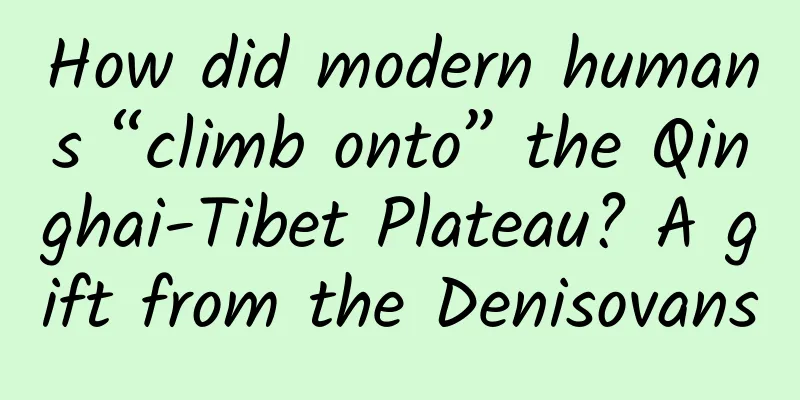How did modern humans “climb onto” the Qinghai-Tibet Plateau? A gift from the Denisovans

|
Produced by: Science Popularization China Author: Niu Changtai (PhD, Nanjing Institute of Geology and Paleontology, Chinese Academy of Sciences) Producer: China Science Expo Editor's note: In order to decode the latest mysteries of life science, the China Science Popularization Frontier Science Project has launched a series of articles called "New Knowledge of Life" to interpret life phenomena and reveal biological mysteries from a unique perspective. Let us delve into the world of life and explore infinite possibilities. “If I have seen further than others, it is because I have stood on the shoulders of giants.” - Isaac Newton From the vast Arctic tundra to the snow-capped Antarctic ice cap, from the thin air of the Qinghai-Tibet Plateau to the 11,000-meter-deep Mariana Trench, from the desert Gobi with flying sand and rocks to the humid and hot tropical rainforest, modern humans have reached almost every corner of the planet, and even conquered and settled here. We can't help but ask what makes us modern humans so adaptable that we stand out from many human species and become the most numerous, most widespread, and only human species on Earth. Is it because we have language? Culture? Or is it because we are “strong” and can adapt to so many environments? As mentioned in the first sentence, it is undeniable that the reason why we modern humans can adapt to such a vast environment and see such diverse landscapes is to some extent because we stand on the shoulders of our extinct relatives, Neanderthals and Denisovans. Neanderthals and Denisovans are the two ancient humans that are most closely related to us modern humans in geological history. Their common ancestor parted ways with the ancestors of modern humans about 800,000 to 500,000 years ago, and the two also diverged shortly thereafter. Current ancient DNA research shows that after our ancestors walked out of Africa 60,000 to 50,000 years ago, they met Neanderthals and Denisovans in Eurasia and genetic exchanges took place. Skulls of modern humans (left) and Neanderthals (right) (Image source: Wiki) Today, all modern humans outside of Africa have about 2% Neanderthal ancestry, and Africans north of the Sahara Desert have up to 1% Neanderthal ancestry. Today's Asian populations and American Indians have about 0.2% Denisovan ancestry, Philippine Negritos have 5-6% Denisovan ancestry, and the indigenous peoples of Melanesia and Australia have about 4% Denisovan ancestry. In a sense, Neanderthals and Denisovans are not extinct; they still exist in our genomes. Denisova 3 fossil replica (Image source: Wiki) So do the Neanderthal and Denisovan genes in our bodies have an impact on our bodies? The answer is yes. The study of the ancient genomes of these two ancient humans found that the gene fragments they inherited to modern humans have important effects on modern humans' immunity, metabolism, fertility, etc., both positive and negative. Among the many positive effects, a very typical case is the genetic contribution of the Denisovans to the adaptation of modern humans living on the Qinghai-Tibet Plateau to low-oxygen life at high altitudes. Today, Tibetans living on the Qinghai-Tibet Plateau and Nepalese living in the southern foothills of the Himalayas have mutated EPAS1 genes. The normal type of this gene helps humans produce more hemoglobin when the oxygen concentration in the body decreases (such as during exercise), but when the hemoglobin in the blood increases too much, it will increase blood viscosity and reduce blood flow rate. If the oxygen supply in the environment is sufficient, there is no big problem, and even the increase in hemoglobin helps improve the body's motor function. But if the oxygen concentration in the environment is low, then the viscous blood will cause the blood flow rate to slow down, which will aggravate the lack of oxygen supply, cause people to have altitude sickness, and at the same time cause vascular diseases such as high blood pressure and heart disease, and also reduce the weight and survival rate of newborns. The EPAS1 gene mutation of Tibetans and Nepalese prevents them from producing too much hemoglobin in a low-oxygen environment, which helps to reduce the viscosity of their blood and maintain a higher blood flow rate, thereby improving the blood's ability to transport oxygen. Interestingly, except for modern people on the Qinghai-Tibet Plateau, this mutation is rarely seen in modern people in other parts of the world, and only about 9% of the Han Chinese population carry similar gene mutations. Is it just a coincidence? In 2014, a study published in Nature found that the EPAS1 gene mutation of Tibetans is very consistent with the EPAS1 gene mutation of Denisovans who lived in the Altai region 80,000 to 50,000 years ago, indicating that the EPAS1 gene mutation of Tibetans is likely inherited from Denisovans. Since a small number of Han Chinese also have similar mutations, this means that it is likely that the ancestors of East Asian populations, including Tibetans and Han Chinese, had genetic exchanges with Denisovans and acquired the EPAS1 gene mutation from Denisovans. After the ancestors of Tibetans arrived at the Qinghai-Tibet Plateau, under the natural selection of low oxygen concentration, the Denisovan-type EPAS1 gene mutation quickly spread among Tibetans and successfully helped them adapt to the plateau environment. When and where did the genetic exchange between East Asians and Denisovans occur? Did Denisovans really have the ability to live on the Qinghai-Tibet Plateau? Chinese paleoanthropologists and archaeologists have found the answer in the Baishiya Karst Cave on the Qinghai-Tibet Plateau. References: 1.Huerta-Sánchez E, Jin X, Asan, et al. Altitude adaptation in Tibetans caused by introgression of Denisovan-like DNA[J]. Nature, 2014, 512(7513): 194-197. 2. Zhang 3.Peyrégne S, Slon V, Kelso J. More than a decade of genetic research on the Denisovans[J]. Nature Reviews Genetics, 2024, 25(2): 83-103. 4. Ma Yanran, Xiang Fenggang. Discovery of Neanderthal and Denisovan genomes and their impact on modern humans[J]. Chinese Science Bulletin, 2022, 67(36): 4337-4343. 5. Xia Huan, Zhang Dongju, Chen Fahu. Denisovans and their research progress[J]. Chinese Science Bulletin, 2020, 65(25): 2763-2774. |
<<: Decreased immunity, hair loss, loss of appetite? Latest research: Your body may be lacking TA...
>>: What? The Earth briefly has a "second moon"? It's a limited-time "mini moon"!
Recommend
Contact list of iOS online mainstream channels for mobile game applications
Table of contents: 1. Contact information of iOS ...
Don't pee in the river, it will attract "tench fish"
In 1829, German biologist Carl Friedrich Philipp ...
Brand Marketing: How to create rituals that work like superstitions?
When talking about rituals, most people will firs...
This detail is so wonderful! The opening and closing ceremonies turned out to be a "serial drama"...
last night Beijing 2022 Winter Olympics Closing C...
In-depth analysis | How to effectively control promotion costs and improve ROI
Search engine marketing has been carried out in m...
It is a "cheap eye-protecting vegetable". The more you eat it, the brighter your eyes will be! It can also supplement calcium and resist aging. It is now on the market!
Recently, amaranth is in season. As the old sayin...
From being popular to laying off employees, will the trend of shared charging finally stop?
"Unlike shared bikes, which have solved the p...
Copywriting methodology: 1 theme, 3 routines, 5 types and 4 psychological cognitions
Sometimes I wonder what the essence of copywritin...
Do fish drink water? Do fish pee? Do fish have a memory of only 7 seconds? Even more interesting is...
Expert of this article: Lin Zhideng, PhD in Zoolo...
LG G3 first-hand experience: amazing/perfect
It is rumored that LG G3 is a performance monster....
"5 Public Account Monetization Projects from 0 to 1" 10 exclusive promotion channels for public accounts, which have gained 200,000 followers after testing!
Training course video content introduction: The o...
The only semi-annual review of WeChat Mini Programs personally compiled by Zhang Xiaolong!
This will be the only article that deeply interpr...
Movement Disorders: COVID-19 infection may increase risk of Parkinson's disease, study finds
According to a recent study, the coronavirus can ...
100% Method to Create a Hot Short Video Account
In the era of attention economy, short videos hav...
5 copywriting skills, do you master them if you are in operation?
There are two characteristics of excellent operat...









